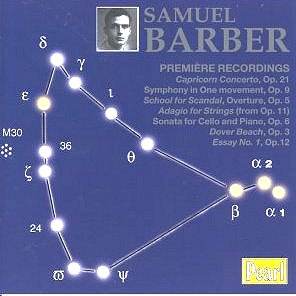With the exception of the very rare Dover Beach
set, these mono U.S. recordings are from the 1940s; three from the
period of the USA's engagement in the Second World War.
The Capricorn Concerto flickers and Pulcinellas
away in Saidenberg's hands with more romantic juice than the
later recording on Everest and this despite being taken from audio material
that has taken some bruising from time's battering.
Amazing how well dynamic contrast is conveyed in the
Ormandy Essay No. 1. This delves deeply into a lode later exploited
so fruitfully by Howard Hanson in his Second Symphony and previously
familiar from Barber's own First Symphony and from Dover Beach itself.
Walter finds smiling grace as well as relentless angst in the Symphony
(modelled on Sibelius 7 though in four sections - each separately tracked
here). I am convinced that this mid-European stance is what prompts,
with such force, memories of Vaughan Williams' Tallis Fantasia in
the Andante Tranquillo (track 13) as well as auguries of William
Alwyn's pre-Raphaelite Lyra Angelica. If you have trouble with
Barber the protesting romantic then this version will win you over to
the symphony. When you contrast it with David Measham's version (on
a long gone late-1970s Unicorn RHS LP) you realise what variety of approach
can be accommodated by this work. The original discs are in very good
fettle contrasting with the narrow constriction of the results achieved
only a year later for the Capricorn Concerto on the Concert Hall
label.
Barber's singing of Dover Beach has the advantage
of his clearer diction and smoother production when compared with the
later Columbia recording by Fischer-Dieskau. The Curtis are more alive
to the sunless passion of this piece than the DF-D's 1967 Juilliard
on Sony Classical MPK 46727.
Janssen, an MGM Hollywood fixture, here gives the overture
more vehemence and beef than I am accustomed to. It is more akin to
the Essays than to say Arthur Benjamin's Overture to an Italian Comedy
or Bax's Overture to a Picaresque Comedy.
We have only to glance at the roster of performers
to detect how highly Barber was esteemed in the 1930s and 1940s. That
said Saidenberg, Janssen and Garbousova are not exactly big names by
comparison with Ormandy, Walter and Toscanini. Garbousova makes a warm
exponent of the romantic and un-garrulous sonata which, however, lacks
strongly memorable invention.
These varied delights (all première recordings)
are packed together with the same generosity to be found in Pearl's
other Barber disc (Symphony No. 2, Cello Concerto, Medea Suite on Pearl
GEM 0151 running to 77.47). The irresistible and varied virtues of this
disc are accentuated and contributed to by the six page 'sleeve-note'
by Dr Arthur E Zimmerman, by sound booklet cover design decisions (not
a consistent strain in the Pearl catalogue), by rare photographs contributed
by Jacob Harnoy (whose own historic record-line we hear too little of)
and by Pearl's discographical detailing - the latter an exemplar to
the industry.
Rob Barnett


